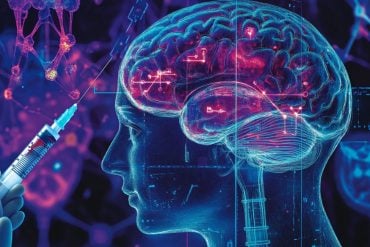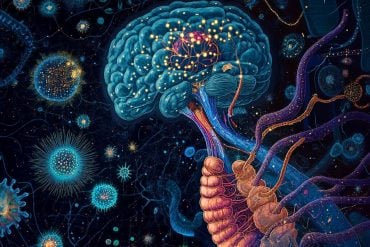Summary: People with myopia appear to have delayed circadian rhythms and lower production of melatonin in the brain compared to those without the visual problem.
Source: Flinders University
New research from Flinders University in Australia indicates people with myopia are more likely to experience poorer sleep quality than people with normal vision.
The study indicates that people with short-sightedness have more delayed circadian rhythms and lower production of melatonin, a hormone secreted in the brain and responsible for regulating sleep at night, compared to people with normal vision.
People affected by myopia or short-sightedness are familiar with the frustration of only being able to clearly see objects up close, but not a far distance.
Optometrist Dr Ranjay Chakraborty , from the Flinders University Caring Futures Institute, says the study adds to the growing evidence of the potential association between disruption of the circadian rhythm and the development of myopia.
“Disruptions in circadian rhythms and sleep due to the advent of artificial light and the use of light-emitting electronic devices for reading and entertainment has become a recognised health concern in several fields, but its impact on eye health has not been studied extensively,” he says.
“These findings provide important evidence that optimal sleep and circadian rhythms are not only essential for general health, but also for good vision.”
In the study, conducted in collaboration with the Flinders University Sleep Institute, the circadian timing and production of melatonin was measured in both people with myopia and people with normal sight. All participants were university students, aged in their twenties.
Melatonin is a hormone secreted by brain’s pineal gland to maintain the body’s sleep-wake cycle and circadian rhythms. We produce melatonin soon after the onset of darkness, peaking our secretion between 2-4am.
Dr Chakraborty says the levels of melatonin were measured in participants through saliva and urine samples, and that the young adults with myopia had significantly delayed circadian rhythms and lower outputs of melatonin compared to normal sighted participants.
Myopia is the most common vision disorder among children and young adults and in severe cases predisposes them to several blinding diseases in adulthood such as retinal tear and detachment, glaucoma, and cataracts.
People with myopia can see objects near to them clearly, but objects far away – like road signs – are blurry. The condition is caused by excessive elongation of the eye in childhood. As a result the rays of light entering the eye focus in front of the retina instead of directly on the retina, causing blurriness.
Myopia generally occurs in children around the stage of puberty but can also appear at any age in early childhood. Global cases of myopia are on the rise, with some research indicating a link between excessive screen use and on the onset of the condition.
Dr Chakraborty says children’s sleeping habits and exposure to screen time must be re-evaluated to reduce the chances of myopia progressing in young people.

Adequate sleep is critical for learning, memory, sustained attention, academic performance at school, and general wellbeing of children during the early development,” he says.
“A lot of digital devices emit blue light, which can suppress the production of melatonin and cause delay in circadian rhythms at night, resulting in delayed and poor sleep.
“It is important to limit the exposure to digital devices in children, particularly at night, for ensuring good sleep and healthy vision.”
In terms of next steps from this research, there are a few options, says Dr Chakraborty.
“Because myopia typically develops during childhood, as a next step, we would like to examine circadian rhythm timing, total production of melatonin sleep and light exposure at night in young children – the actual target population for myopia prevention,” he says.
“Such a study will provide novel insights into the biological and environmental factors underlying myopia, which will aid in early diagnosis and treatment of myopia in children.”
About this visual neuroscience and sleep research news
Source: Flinders University
Contact: Ranjay Chakraborty – Flinders University
Image: The image is in the public domain
Original Research: Closed access.
“Myopia, or near-sightedness, is associated with delayed melatonin circadian timing and lower melatonin output in young adult humans” by Ranjay Chakraborty et al. Sleep
Abstract
Myopia, or near-sightedness, is associated with delayed melatonin circadian timing and lower melatonin output in young adult humans
Study objectives
Myopia, or near-sightedness, is the most common refractive vision disorder and predisposes the eye to many blinding conditions in adulthood. Recent research has suggested that myopia is associated with increased endogenous melatonin production. Here we investigated the differences in melatonin circadian timing and output in young adult myopes and non-myopes (or emmetropes) as a pathogenesis for myopia.
Methods
A total of 18 myopic (refractive error [mean ± standard deviation] −4.89 ± 2.16 dioptres) and 14 emmetropic participants (−0.09 ± 0.13 dioptres), aged 22.06 ± 2.35 years were recruited. Circadian timing was assessed using salivary dim light melatonin onset (DLMO), collected half-hourly for 7 h, beginning 5 h before and finishing 2 h after individual average sleep onset in a sleep laboratory. Total melatonin production was assessed via aMT6s levels from urine voids collected from 06:00 pm and until wake-up time the following morning. Objective measures of sleep timing were acquired a week prior to the sleep laboratory visit using an actigraphy device.
Results
Myopes (22:19 ± 1.8 h) exhibited a DLMO phase-delay of 1 hr 12 min compared with emmetropes (21:07 ± 1.4 h), p = 0.026, d = 0.73. Urinary aMT6s melatonin levels were significantly lower among myopes (29.17 ± 18.67) than emmetropes (42.51 ± 23.97, p = 0.04, d = 0.63). Myopes also had a significant delay in sleep onset, greater sleep onset latency, shorter sleep duration, and more evening-type diurnal preference than emmetropes (all p < 0.05).
Conclusions
These findings suggest a potential association between circadian rhythms and myopia in humans.







